

Empowering Mobile Web Development: Strategies for Enhanced Performance
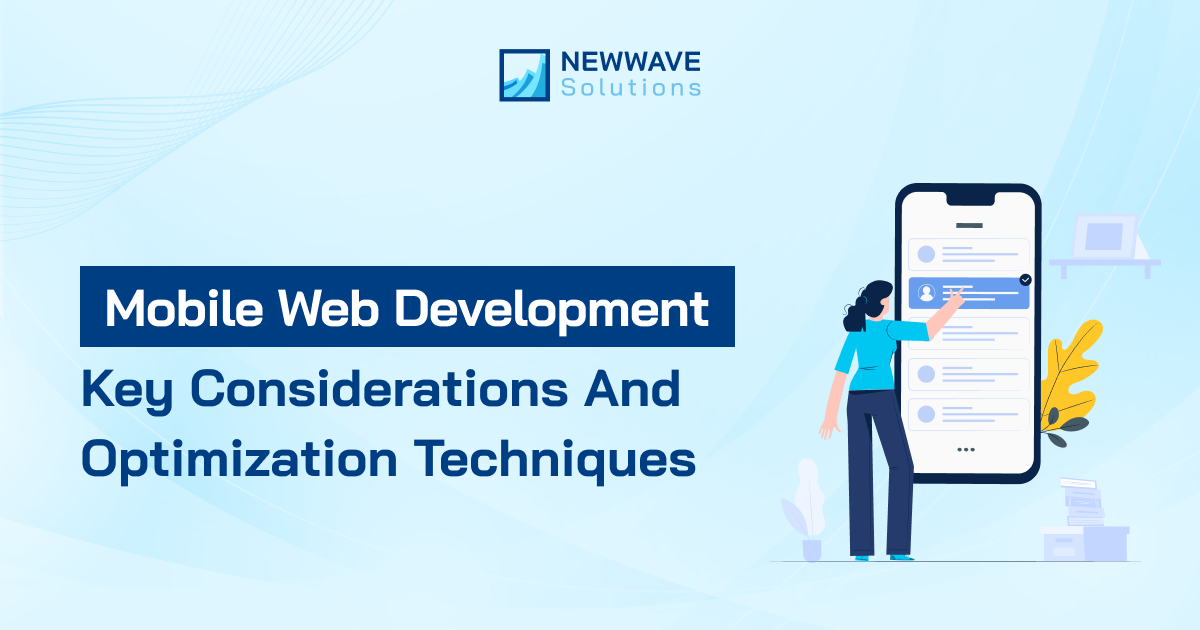
The way we access information and complete tasks online has been dramatically transformed by the surge of mobile devices. From smartphones to tablets, these handy companions have become an extension of ourselves. This shift in user behavior has made mobile web development, creating websites specifically optimized for mobile devices, a critical aspect of any successful online presence.
This guide will equip you with the essential knowledge for mobile web development. Besides, we’ll answer the question “How do mobile applications work” to find the key considerations you need to make when building your mobile website, along with valuable techniques.
Table Of Contents
Toggle1. An Overview for Understanding Mobile Web Development
When someone mentions “mobile web”, they refer to websites or web applications specifically designed for smartphones or tablets. Unlike traditional desktop websites, which may not display properly on smaller screens, these forms are tailored to accommodate mobile devices’ unique constraints and capabilities.
To understand the key differences between mobile websites and mobile web applications, take a look at this table:
|
Aspect |
Mobile Websites |
Mobile Web Apps |
| Development | Typically built using HTML, CSS, and JavaScript. | Developed using web technologies but often wrapped in a native container for distribution. |
| Access | Accessed via web browsers. | Installed as standalone applications from app stores. |
| Installation | No installation is required; accessed directly through a URL. | Installation is required; can be accessed via an app icon. |
| Functionality | Limited functionality compared to native apps. Often focuses on delivering content or basic interactions. | Can offer enhanced functionality and interactivity similar to native apps, including offline capabilities and access to device features. |
| Updates | Updates are immediate and do not require user action. | Updates may require user interaction to install, depending on the distribution method. |
| Performance | Performance may be limited, especially on older devices or slower network connections. | Performance can be optimized for speed and responsiveness, but may not match the performance of native apps. |
| Offline functionality | Limited offline functionality; typically requires an internet connection. | Can offer offline capabilities through caching and storage mechanisms. |
| User Engagement | May have lower user engagement compared to native apps. | Can potentially achieve higher user engagement through push notifications, deep linking, and other native-like features. |
As you can see, each has its strengths and weaknesses. The decision between mobile websites and mobile web apps depends on various factors, including your specific goals, target audience, budget, and required features. Regardless of your choice, both options share mutual precautions due to the differences between desktop and mobile platforms.
>>> See more: Choosing a mobile app design company: Top 11 best in 2024
2. Key Considerations For Optimizing Mobile Web App Development
The way we access the internet has changed dramatically. Today, most people use smartphones and tablets to browse the web. This means that websites need to be designed specifically for these mobile devices, not just traditional computers.
Mobile web development, also known as mobile web programming or mobile web dev, is the process of creating websites that look great and function smoothly on smartphones and tablets. It’s different from regular web development because you need to consider factors like:
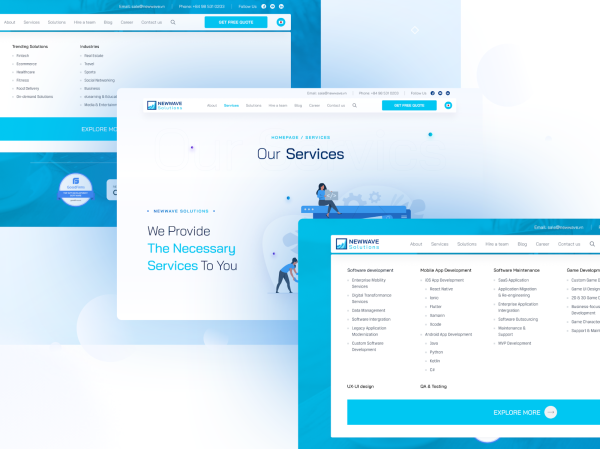
1.1. Mobile APIs
Mobile devices have become an essential part of our lives, and people expect websites to work flawlessly on their smartphones and tablets. This is where mobile web development, a specialized field within the broader realm of web and mobile development and software and app development, comes in. It’s all about creating websites specifically designed to look great and function smoothly on mobile screens.
One of the key tools mobile web developers use is mobile APIs (Application Programming Interfaces). Think of them as messengers that allow your website to “talk” to a mobile device’s features. Here are some common mobile APIs and what they can do for your website:
- Location API: This lets your website know where a user is. Imagine using this feature in web and mobile app development to find nearby restaurants or stores on a map!
- Sensor APIs: These APIs tap into a device’s built-in sensors like the gyroscope or accelerometer. This can be used to create fun and interactive experiences, like tilting your phone to navigate a game in a mobile application development process.
- Camera and Media APIs: Ever used your phone’s camera to upload a photo to a website? That’s thanks to camera APIs! These APIs also allow features like video playback, crucial for some web and mobile app development.
- Offline Web Applications: Who wants a website that sputters when the internet cuts out? Mobile APIs can make your website work offline, so users can still access some features even without a connection. This can be particularly valuable in the mobile application development process.
By understanding and using these mobile APIs, web developers can create mobile websites that are engaging, functional, and adapt to the user’s device. This translates to a better experience for your visitors and keeps them coming back for more!
1.2. Touch Screens
Unlike the familiar mouse and keyboard combo used on desktops, touch screens demand a different approach in web and mobile development, particularly mobile website development. This section dives into the key considerations for crafting a successful mobile web experience. Here’s what mobile web developers need to know about touchscreens:
- Bigger Buttons and Links: Fingers aren’t as precise as a mouse cursor, so make sure buttons, links, and other interactive elements on your mobile website are larger and easier to tap. This is crucial for a positive user experience in both web and mobile app development.
- Gestures Rule: People love using gestures like swiping, pinching, and tapping on their phones and tablets. Mobile web development can take advantage of these natural touchscreen gestures to create a fun and intuitive user experience for your website visitors. This can even inspire similar interactions in the mobile application development process.
- Feeling the Feedback: Haptic feedback, like a little vibration or a short animation when someone taps something, can make your mobile website feel more responsive and satisfying to use. This can be a subtle but effective touch that enhances the user experience across web and mobile development.
By thinking about how people use touchscreens, mobile web developers can create user-friendly interfaces that are built specifically for mobile devices. This will keep your visitors happy and coming back for more!
>>> See more: Finding The Best React Native Development Company
1.3. Cross-Browser Development
When building websites specifically for mobile devices, ensuring they work well on different web browsers is crucial. This is especially important in the world of web and app development, where browser fragmentation can be a challenge. Browser fragmentation refers to the existence of many mobile browsers, each with its way of displaying things and supporting features.
As a mobile web developer, you’ll want to consider a few things to make sure your website renders well and functions smoothly across these various web and mobile browsers used by your target audience.
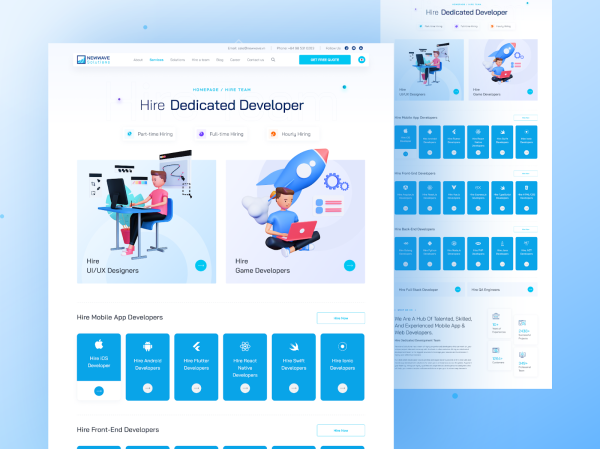
- Testing Across Browsers: Just like trying on clothes before you buy them, it’s important to test your mobile website on different popular browsers like Chrome, Safari, Firefox, and Samsung Internet. This ensures everything looks and works as expected for users, regardless of their chosen browser.
- Adapting to Feature Variations: Not all browsers support the same features. Feature detection is a technique commonly used in web and mobile application development to check which features a user’s browser has. You can then adjust your website accordingly. For example, if a fancy animation isn’t supported, you might show a simpler image instead.
- Providing Alternatives: For features that some browsers might not understand, you can leverage polyfills or shims. These are essentially workarounds that provide a similar function, even if the browser doesn’t natively support it. This helps ensure a consistent and positive experience for everyone who visits your mobile website.
By taking care of these cross-browser compatibility concerns, you can create mobile website development that works well on a wide range of devices and browsers, giving users a smooth and enjoyable experience no matter how they access your website. This contributes to a positive user experience in both web development and mobile app development.
>>> See more: Unleashing The Power Of Custom Application Development Services
3. Essential Criteria to Consider When Evaluating Web App Development
Mobile web development focuses on creating websites specifically designed for mobile devices. This differs from mobile app development, which involves building standalone applications downloaded and installed on a phone or tablet. Many users access the internet primarily through their phones. A mobile-friendly website provides several advantages:
2.1. Performance Optimization: Keeping Your Mobile Website Speedy
Ensuring optimal performance is a critical aspect of both mobile web development and mobile application development. Users expect lightning-fast load times and responsive interactions, no matter how they access your content. Here are some techniques for performance optimization in web and mobile development:
- Minimize requests and optimize files: Reduce the number of downloads your website needs by combining and minifying CSS and JavaScript files. Optimize image sizes and use lazy loading, which only downloads images as users scroll down the page. This applies to both mobile websites and mobile apps.
- Caching magic: Leverage browser caching, service workers, and other techniques to avoid users downloading the same things repeatedly. This makes the website feel faster and improves user experience. These caching techniques can be implemented in web and mobile app development.
- Content Delivery Networks (CDNs) to the rescue: Serving static content like images and code from a CDN can dramatically improve website speed, especially for users in different regions. This is a valuable strategy for both web and mobile app development.
- Mobile network friendly: Mobile users often have limited data and slower connections. Optimizing your website for efficient data usage will function smoothly even on slower networks. This optimization technique is crucial specifically for mobile web development.
By prioritizing performance, your mobile website will feel smooth and responsive, even for users with slower connections. This focus on performance translates to a better user experience for both web and mobile app development.
2.2. Responsive Design: Making Your Mobile Website Fit Any Screen
Responsive design is a fundamental principle of mobile web development, ensuring that web applications adapt and scale seamlessly across a wide range of device sizes and screen resolutions. Key aspects of responsive design include:
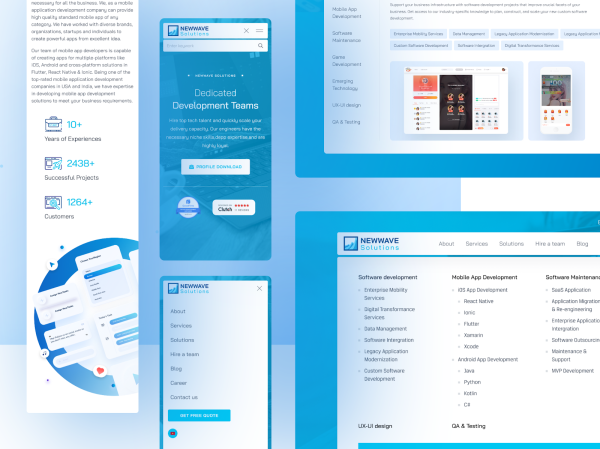
- Flexible Layouts: By utilizing a fluid grid layout with relative units (percentages or viewport units) and media queries, your website can adjust automatically to different screen sizes, whether it’s a giant desktop monitor or a tiny smartphone screen. This is crucial for web and app development, as it ensures users have a positive experience regardless of their device.
- Content Optimization: Restructuring and optimizing your content, text size, and user interface elements for various screen sizes is paramount. This ensures everything remains easy to read and use without compromising the user experience across web and mobile applications.
- Media Query Mastery: Leveraging media queries in CSS empowers you to apply specific styles and adjustments based on the device’s characteristics, like screen size, orientation, and pixel density. This fine-tuning ensures an exceptional experience for users on any device, further solidifying the value of responsive design in web and mobile development.
By embracing responsive design in your web and mobile development project, you can create a mobile website that provides a consistent and enjoyable experience for users on any device, maximizing engagement and user satisfaction.
2.3. Mobile SEO Best Practices
Optimizing a mobile web application for search engine visibility and user experience is crucial for ensuring its discoverability and accessibility in mobile search results. By following key mobile SEO best practices, you can significantly improve your web and mobile application development efforts. Here are some important considerations:
- Mobile-friendly content: Make sure your website’s content and structure are optimized for mobile devices, with clear layouts and easy navigation. This not only enhances user experience but also caters to Google’s mobile-first indexing approach.
- Structured data markup: Implement structured data (like schema.org markup) to give search engines more information about your website’s content. This helps your website appear more prominently in mobile search results, leading to increased discoverability and potential conversions.
- Mobile-first indexing: As Google prioritizes the mobile version of websites when searching and indexing, ensure your mobile website is up-to-date and has the most important content. This aligns with the mobile-first development philosophy and strengthens your mobile SEO strategy.
- Mobile page speed is king: Just like for website performance, mobile page speed is a crucial factor for mobile search ranking. A faster website improves user experience and SEO performance, ultimately driving more relevant traffic and conversions for your web and mobile app development endeavors.
By adhering to these mobile SEO best practices, mobile website development can significantly improve their visibility, discoverability, and user engagement in mobile search results. This translates to attracting more relevant users, boosting conversions, and achieving success in the competitive mobile app development landscape.
>>> See more: Mobile App Development Company USA: Top Picks For 2024
3. Crafting an Exceptional Mobile Web Experience by Leveraging Three Key Factors
Mobile web development goes beyond just writing code. To create a truly successful mobile experience (mobile UX), there are several important factors to consider for both web and mobile app development and mobile website development.
3.1. User Experience Design
Imagine using your website on a tiny phone screen, that’s what mobile-friendly navigation is all about. It means prioritizing clear menus, easy access to key features, and a layout that can be navigated with one hand.
Think about how you hold your phone – buttons and features should be within easy reach of your thumb. This user-centered design approach applies not only to mobile web development but also to the entire web and mobile application development process, including software and app development.
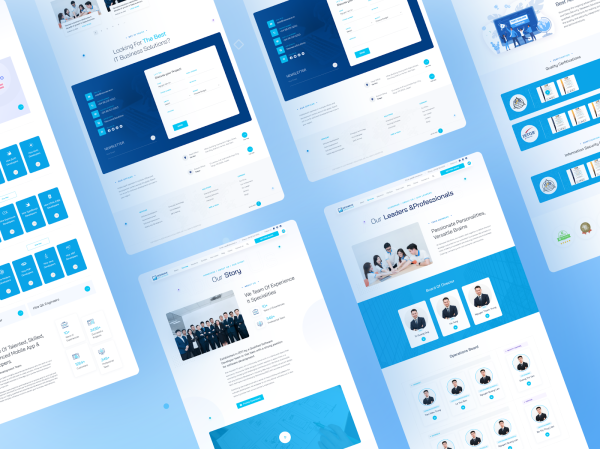
Everyone deserves a good experience online, including people with disabilities. Accessibility features like larger text, alternative text descriptions for images, and keyboard navigation avoid heavy reliance on touch and ensure your mobile website adheres to WCAG (Web Content Accessibility Guidelines).
Finally, since most interactions on mobile are done by touch, optimize buttons and other UI elements for touchscreens. Use larger, well-spaced buttons and design gestures that are intuitive and responsive (touchscreen optimization).
By focusing on UXD, your mobile website becomes a user-friendly and engaging experience, perfectly suited for the way people use their phones.
3.2. Security and Privacy
Mobile websites often handle sensitive user data, so security and privacy are paramount concerns in both web and mobile app development, as well as software and app development. Here’s what to consider to build trust with your users and ensure a safe online experience:
- Secure Authentication: Implement strong login methods like two-factor authentication or fingerprint scanners to safeguard user accounts and data across web and mobile applications.
- Data Encryption: Encrypt all user data, both in transit and at rest, to protect it from potential breaches in web and mobile development projects.
- Location Data and Permissions: Be transparent about why you need to collect location data or other permissions from users in both web and mobile apps. Only collect what’s necessary, and provide clear explanations about how this data is used.
- Ongoing Security Monitoring: Regularly check your mobile website and web applications for security vulnerabilities and promptly fix any issues with updates and patches. This is an essential part of the ongoing mobile development process and software development process.
By prioritizing security and privacy, you can build trust with your users and ensure a safe online experience.
3.3. Testing and Iteration
Just like with the mobile application development process, thorough testing and continuous improvement are essential for a successful mobile website. Here’s what to consider for mobile web dev and mobile development process:
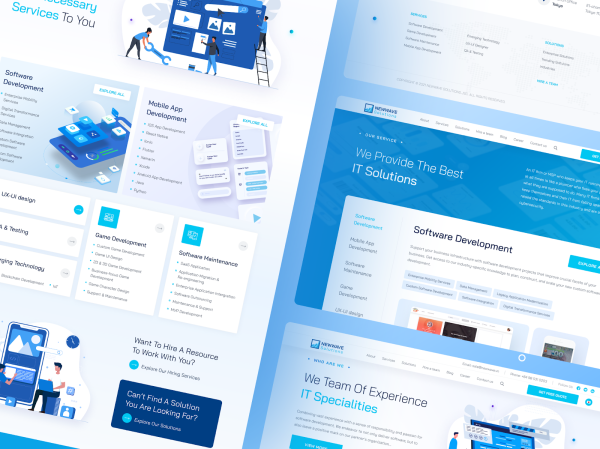
- Device and Platform Testing: Test your website across a wide range of devices, operating systems, and browsers to ensure it works well everywhere.
- Real-world Usability Testing: Get real people to test your website and provide feedback on its usability, navigation, and overall user experience. Use this feedback to make improvements.
- Performance Monitoring: Continuously monitor your website’s performance, how users interact with it, and conversion rates. This data will help you identify areas for improvement and make informed decisions for future development.
- Iterative Development: Use an agile development approach where you can make frequent updates and improvements based on user feedback and testing results. This ensures your mobile website keeps evolving to meet the ever-changing needs of mobile users.
By following these mobile web development considerations, you can create a mobile website that delivers an exceptional user experience and keeps your users engaged.
>>> See more: Unlocking Immersive Experiences With AR Development
4. Conclusion
The world of mobile web development is constantly evolving, presenting both challenges and opportunities for web developers and designers. By understanding the unique considerations, best practices, and strategies outlined in this blog post, you can unlock the potential of the portable web and create engaging, responsive, and secure mobile web applications that captivate and delight users.
From optimizing for mobile-specific APIs and touch-screen interactions to implementing robust performance optimization and responsive design techniques, the key to successful mobile web development lies in a deep understanding of the mobile landscape and a relentless focus on user experience.
As you embark on your mobile web development journey, remember to continuously test, iterate, and adapt your approach to meet the ever-changing needs of your mobile audience. By embracing the power of the mobile web, you can unlock new avenues for innovation, user engagement, and business growth.
Newwave Solutions empowers businesses to thrive in the mobile age. We offer a comprehensive suite of mobile web development solutions, tailored to your specific needs and goals. From concept to creation and beyond, our team of experienced professionals will guide you every step of the way.
Contact Information:
- Head Office (Hanoi): 1F, 4F, 10F, Mitec Building, Duong Dinh Nghe Street, Yen Hoa Ward, Cau Giay District, Hanoi City, Vietnam
- Branch Office (Tokyo): 1chōme118 Yushima, Bunkyo City, Tokyo 1130034, Japan
- Hotline: +84 985310203
- Website: https://newwavesolution.com
- Email: [email protected]
To Quang Duy is the CEO of Newwave Solutions, a leading Vietnamese software company. He is recognized as a standout technology consultant. Connect with him on LinkedIn and Twitter.
Table Of Contents
Toggle














